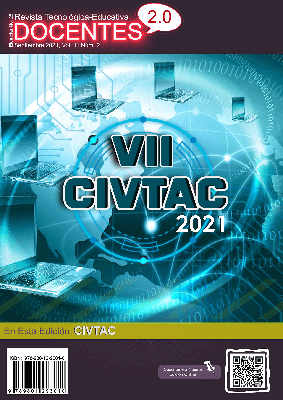Integrated Learning of Social Sciences and English through a Didactic Unit Based on Local Geography
 DOI:
https://doi.org/10.37843/rted.v11i2.254
DOI:
https://doi.org/10.37843/rted.v11i2.254
Main Article Content
Abstract
Communication and social interaction are the raison d'être for using a language. Therefore, language teaching should privilege skills related to oral production and listening comprehension. This research contrasts the difficulty in teaching and learning English from a communicative approach with content and language integrated learning (CLIL). This contrast was given using the design of a didactic unit of social sciences to analyze the incidence of CLIL in students between 12 and 14 years old at the José Odel Lizarazo Institution. For this, the approach was carried out from a qualitative paradigm, proposing that the didactic unit starts from the local geography of the department of Arauca and with the considerations of the task-based approach. The analysis was carried out using observation, field notes, audiovisual record, entry-exit questionnaire, which allowed us to understand that a good performance in the listening skill fostered oral production. On the other hand, integrating content from social sciences and English favored active learning in students. Finally, CLIL offered an alternative to the linguistic needs of the students.
Downloads
Metrics
Article Details

This work is licensed under a Creative Commons Attribution-NonCommercial-NoDerivatives 4.0 International License.
Those authors who have publications in our journal accept the following terms:
- When a work is accepted for publication, the author retains rights of reproduction, distribution of his/her article for exploitation in all countries of the world in the format provided by our magazine and any other magnetic medium, optical, and digital.
- Authors will retain their copyright and guarantee the journal the right first to publish their work, which will be simultaneously subject to the Creative Commons Acknowledgment License (Attribution-NonCommercial-NoDerivatives 4.0 International (CC BY-NC-ND 4.0)). That allows third parties to copy and redistribute the material in any medium or format, under the following conditions: Acknowledgment - You must properly acknowledge authorship, provide a link to the license, and indicate if any changes have been made. You may do so in any reasonable way, but not in a way that suggests you have the licensor's endorsement or receive it for your use. NonCommercial - You may not use the material for a commercial purpose. NoDerivatives - If you remix, transform, or build from the material, you cannot broadcast the modified material. There are no additional restrictions - You cannot apply legal terms or technological measures that legally restrict you from doing what the license allows.
- Authors may adopt other non-exclusive license agreements to distribute the published version of the work (e.g., deposit it in an institutional archive or publish it in a monographic volume) provided that the initial publication in this journal is indicated.
- Authors are allowed and recommended to disseminate their work through the Internet (e.g., in institutional telematic archives, repositories, libraries, or their website), producing exciting exchanges and increasing the published work's citations.
- Request of withdrawal an article has to be done in writing by the author to the Editor, becoming effective after a written response from the Editor. For this purpose, the author or authors will send correspondence via e-mail: [email protected].
- The author will not receive financial compensation for the publication of his work.
- All Docentes 2.0 Journal publications are under the Open Journal System (OJS) platform at: https://ojs.docentes20.com/.
References
Álvarez, A. y Alvarez, V. (2014) Métodos de la investigación educativa. Universidad pedagógica Nacional.
Ball, P., Clegg J. & Kelly, K. (2015). Putting CLIL into Practice. Oxford University Press.
Bisquerra, R. (2004) Metodología de la investigación educativa. Editorial la muralla.
Chenlu, L. (2015). Application of Communicative Method in EFL Listening and Speaking Class. Studies in Literature and Language, 10 (5), 1-4.
Contreras, O. (2012). Stephen Krashen: sus aportes a la educación bilingüe. Rastros Rostros, 14 (27). https://revistas.ucc.edu.co/index.php/ra/article/view/491
Corbin J. & Strauss A. (2002) Bases de la investigación cualitativa. Técnicas y procedimientos para desarrollar la teoría fundamentada. Universidad de Antioquia
Hernández-Sampieri, R. Fernández-Collado, C. & Baptista-Lucio, P. (2014). Metodología de la investigación. McGraw-Hill.
Ministerio de Educación Nacional de la República Colombiana. (2004). Formar para la ciudadanía… ¡Sí es posible! Ascofade. http://www.mineducacion.gov.co/1621/articles-75768_archivo_pdf.pdf
Ministerio de Educación Nacional República de Colombia. (2006). Formar en Lenguas extranjeras: El Reto, lo que necesitamos saber y saber hacer. Espantapájaros Taller.
Howatt, APR. (1984). A History of English Language Teaching. Oxford University Press.
Marín, J. (2018) Investigar en educación y pedagogía, sus fundamentos epistemológicos.
Marsh, D. (2002). Clil/Emile: The European Dimension, Action, Trends and Foreignt Potential. http://europa.eu.int/comm/education/languages/index.html
Ministerio de educación (2019). Encuentro regional saber, ICFES.
Nunan, D. (2004). Task-Based Language Teaching. Cambridge Language Teaching Library. DOI: https://doi.org/10.1017/CBO9780511667336
PEI (2012). Proyecto Educativo Institucional. Institución Educativa José Odel Lizarazo.
Tamayo-Tamayo, M. (2004). El proceso de la investigación científica-Limusa. Noriega Editores.






